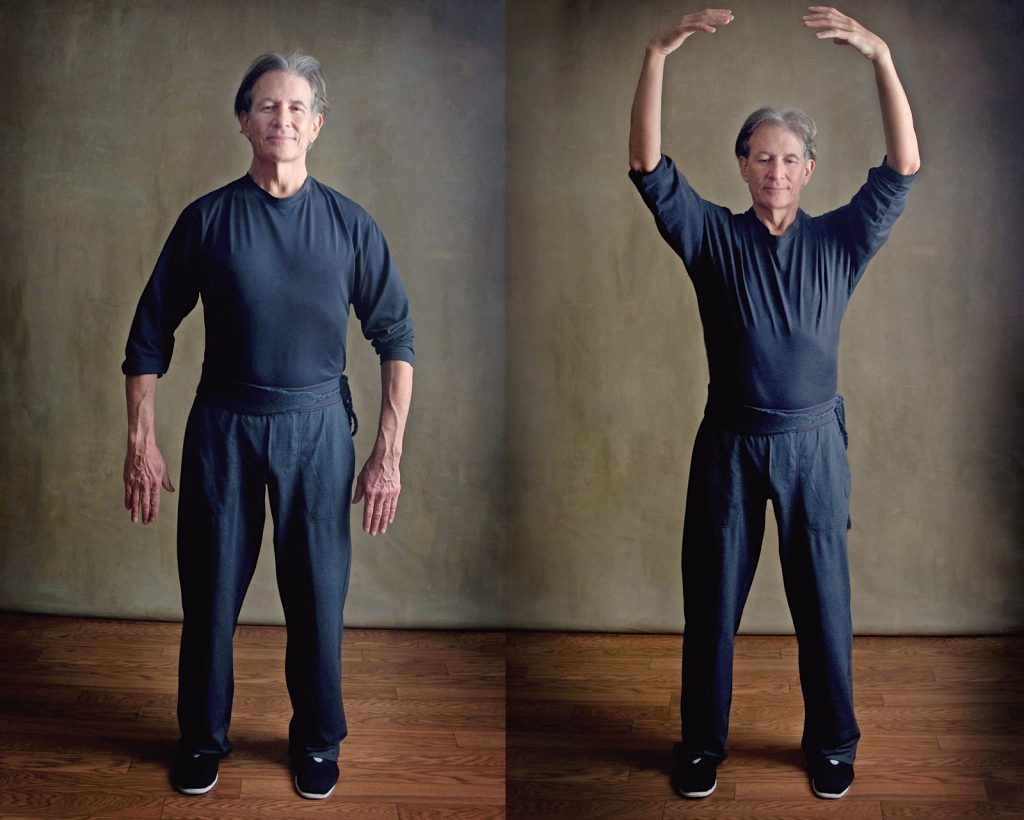To watch videos of Teja Bell demonstrating qigong postures, click here. Videos produced and directed by Calder McCall.
I began the practice of meditation at the age of 15 during my martial arts training, which began over 40 years ago. My teacher, Tatsumo Makami, would sit us in seiza (kneeling) posture for a few minutes before class. He seemed to take delight in straightening my back, adjusting my head, and trying to slow my breathing down, while my knees ached and my patience waned. I couldn’t wait until meditation time was over so I could get on to what I thought was the real stuff of martial arts—kicks, punches, and throws with loud kiai shouts.
Later, as I looked more deeply into my martial arts practice and began studying Asian arts and philosophies from many different cultures and traditions, I began to see that one of the threads interconnecting them all at the highest levels is the practice of stillness—and then the practice of stillness in action. Over the decades, meditation has become central to all of my embodiment arts: aikido, yoga, and Chinese martial arts such as taiji, xingyi, bagua, and liuhebafa. At the root of all of the Chinese internal martial arts is qigong—the powerful system of energy practices that have in turn supported the expansion and deepening of my meditation practice.
The Chinese word qigong means “energy cultivation.” Qi is the universal life-force, and gong is both the action and the result of sustained effort over time. The practice of qigong honors and cultivates this “energy” aspect of our being—the matrix of life-force that permeates our physical body—and thus supports the development of holistic well-being.
Some anthropological research suggests that qigong originated in China around the second millennium B.C.E., with a well-established later history as part of both Taoist and Buddhist contemplative traditions. Qigong is a complete meditative practice in itself as well as a perfect complement to any other form of meditation. It empowers meditators with calm, clear vitality, strength, and vibrant health—bringing peace to the body, heart, and spirit.
Wise qigong practice can reset and balance the nervous system by releasing tension, and softening and lengthening the breath through mindful action. Thus qigong is really a way to offer metta (lovingkindness) and compassion toward ourselves.
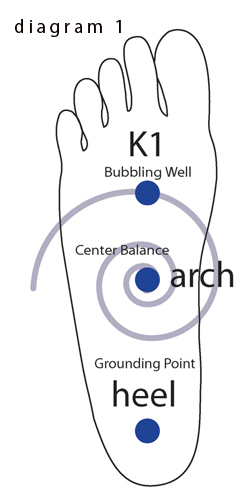
I teach a form of qigong for meditators that I call Radiant Heart qigong. The benefits of Radiant Heart qigong practice for meditators are many. To begin with, the forms are accessible to almost every fitness level and can (indeed, should) be modified to fit each individual’s needs. Qigong may be done while standing, sitting, walking, and even lying down.
The ease of performing qigong belies the transformative power it offers. It is precisely this ease that allows its mindful practice to open the gateway to the direct experience of being— a quality that I call “presence awareness,” which can refer both to an action and to a state of being. As an action, “presence awareness” is to bring the fullness of our attention to an object—the breath, for example, or any feature of the physical or energetic body, the mind, or the emotions. When we rest in presence awareness, we embody a kind of poise of being in which we are present to our interconnectedness with all of life, and our consciousness can rest in its own pristine and unobscured nature. Qigong unifies the domains of our human being—spirit, mind, and body.
Essential Practice: Standing Meditation
The foundation for the expression of many qigong actions is the gesture known as “standing meditation,” or wuji posture. (Photo 1; Standing Meditation Posture)
In the tradition of qigong, standing meditation plays a central role in the development of the physical, energetic, and spiritual essence of practice. In ancient and contemporary qigong literature, the refinement of standing meditation instructions and techniques is often presented as being absolutely essential to understanding and deepening embodiment.
For traditional meditators the benefit of correctly learning and practicing standing meditation qigong is manifold. By paying attention to the integrity of structural alignment, the practitioner improves posture, increases relaxation and ease, and develops what I call “field awareness” of the body—the ability to be holistically aware of the presence of aliveness that we call “our body.”
Begin in a normal upright posture with your feet about shoulder width or a little wider. Let the feet be parallel with the toes pointing forward. The arch should be lightly lifted, with slightly more weight on the outer edge of each foot. For a moment, look down at your feet and compare your subjective feeling of alignment with the the actual physical alignment. Make any subtle adjustments necessary; then look up and straight ahead. As your arms rest naturally at your sides, bend the elbows slightly to open the space of your armpits.
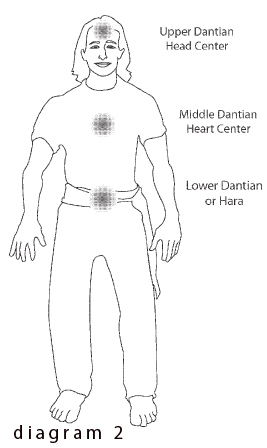
Become present to the sensations of the weight of your body connecting with the surface you are standing on. Sense the three primary energy points on the bottom of your feet, as shown in Diagram 1. Subtly shift your weight between the forward point (K1 in the diagram)—slightly in front of the arch and in the center of the foot—and the center of the heel point. Sense the center point in the arch that is the balance and stable grounding point of the body.
Have the knees slightly bent, not locked. Relax the hips and pelvis and let the tailbone settle downward. This action begins to flatten the lower lumbar area, encouraging the body’s weight to flow through the legs into the earth. Develop the feeling of connecting with the earth and with the quality of natural, grounded stability.
Soften the back of the neck by bringing the chin slightly down and inward, keeping the throat open. This encourages the head to lift gently and the crown to open energetically. Remember, don’t strain or stress. Lightly press the back of the crown of the head upward to open and lengthen the cervical vertebrae. This optimizes circulation and energy flow to and from the brain, through the spinal cord and neural network.
Now soften and relax the jaw and the muscles of the face. Allow the tongue to rest lightly touching the upper palette. Relax the jaw and the temporomandibular joint (TMJ), the hinge that connects the lower jaw to the skull. Keep your eyes—whether open or closed—soft and peaceful, with the peripheral vision open.
Establish natural abdominal breathing in a way that releases tension throughout the field of the body. Take time to feel and cultivate these qualities of breath: soft; smooth; even; natural; and deep (but not to maximum capacity—aim for the 70 percent range).
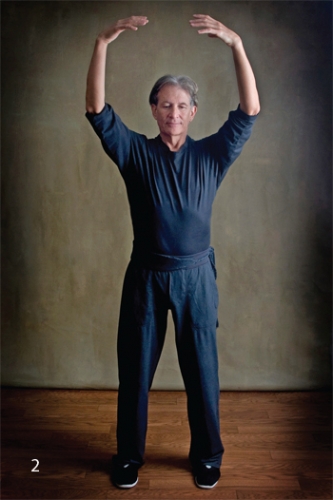
Now sense the energetic “centerline” that flows through the core of your body. This is like a vertical axis that connects the three dynamic centers of the body—the head, the heart (center of the chest), and the hara, or lower dantian. (See Diagram 2) As it is traditionally described, this axis connects heaven and earth with and through the individual human in the middle.
Now the physical and energetic being begins to come into alignment, in harmony with itself and the environment. “Presence awareness” is calm and awake. This alignment and poise is meditation, a state that is also the ground for other forms of contemplative practice.
In the standing meditation practice, you may experience a variety of physical and energetic phenomena. Proceed slowly and with patience, beginning with just 3 to 5 minutes and gradually increasing over time.
Radiant Body Breath
From the stillness and stability of the standing meditation posture we open into motion with the Radiant Body Breath. Through this practice, we guide the qi throughout the entire field of the body, smoothing and soothing the energy body while deepening and regulating the breath. As you progress in the practice of Radiant Body Breathing, you may come to feel the whole body breathing—every cell gently pulsing in harmony with a balanced sense of vitality and earth-connectedness.
To begin Radiant Body Breathing from the standing meditation posture, establish the sense of the energetic centerline that flows through the core of the body like a column of light connecting the center of the head with the center of the chest and the center of the hara.
With your arms and hands relaxed at the sides of the body, begin the cycle of inhalation and allow the arms to open to the sides of the body with the palms facing downward. Allow the arms to float upward toward the shoulders. As the arms reach the height of the shoulders, turn the palms upward and let the arms continue their journey above the head.
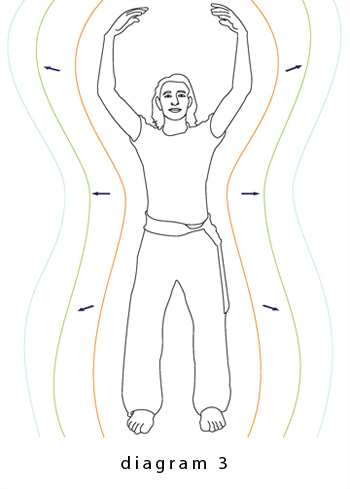
Make this transition smooth and even. Remember to underdo, making sure not to lock the wrists, elbows, or shoulder joints. Cultivate the feeling of expansiveness from within, with your awareness moving from the marrow of the bones to the periphery of the skin and then continuing outward past the boundary of the skin. (See Diagram 3: energy flows)
As the palms reach overhead, they face each other approximately at shoulder width. (Photo 2: Radiant Body Breath, hands overhead) At this point begin the cycle of exhalation, smoothly lowering the arms. As they reach the level of the head begin to turn the palms inward toward the body. As you exhale, the hands continue to descend along the left and right sides of the front of the body. Allow a space of approximately 6 to 12 inches between the palms and the front of the body. (Photo 3: Radiant Body Breath, hands coming down front of body—side view)
Together with the exhalation, feel the qi flowing inward from the periphery of this energetic space, through the skin toward the center of the body, connecting along the energetic centerline and settling itself in the hara.
As the hands finish their journey down the front part of the body with the exhalation, naturally returning to the sides of the legs, one cycle of Radiant Body Breath is completed.
Radiant Body Breath can be practiced from 1 to 20 times in any practice period. Begin with 3 to 6 repetitions and expand the number of cycles as time permits and inclination suggests. It is always the quality of practice that matters; there is no magic in the number of cycles you perform. More is not necessarily better. As you complete your final cycle of Radiant Body Breath, return in a seamless way to wuji, the standing meditation posture. Rest in ease and stillness.

Full Spinal Breathing
For meditators, practicing Full Spinal Breathing can be beneficial for overall alertness, releasing tension of the lower and middle back and shoulder blade area, moving qi inside the body to nourish and bring health to the internal organs, and gently pumping the cerebral spinal fluid along the spinal cord and into the brain. Learn the form of Full Spinal Breathing by first studying the basic mechanics of the actions and then weaving this understanding into a seamless flow of movement and awareness.
Begin in the standing meditation posture. With open palms facing upward at the hips, waist-height, relax your shoulders, allowing shoulder blades to settle downward, smoothly turn the hands palms up, so that the fingertips begin to point inward toward the body, continuing the turning as they point behind the body. (Photo 4: Full Spinal Breathing, hand movement)

Continue the spiral rotation of the upward-turned palms until the fingertips point away from the body and the palms face outward. Continue this elliptical arch of the arms until the backs of the hands come together in front of the body, like a diver getting ready to dive into the water. (Photo 5: Full Spinal Breathing, “C” shape)
The body should be very relaxed in this gesture. The knees are slightly bent, the hips and pelvis are relaxed, and the lower back expands and flattens. The length of the spine assumes a mild “C” shape, like a bow. The shoulder blades move away from the spine as the back rounds. The chin moves in toward the throat, expanding and lengthening the back of the neck.
Stand and feel this shape. Let go of any extra tension or strength, so that you can stabilize the gesture with minimal effort, honoring the principles of ease and underdoing.

Completing a smooth exhale from this “C” shape, with the inhale let the palms turn upward as the elbows move straight back past the lower part of the rib cage, moving the body in the opposite direction and creating a mild forward expanding arch of the chest. (Photo 6: Full Spinal Breathing, inhalation expansion position)
Feel the chest and the heart area relax and expand with the in-breath. That is one cycle of Full Spinal Breathing. To continue another cycle of full spinal breathing, begin your exhale as the palms spiral forward away from the body, coming again into the diver’s stance.
Practice slowly with an evenness of in- and out-breath. You may pause, but do not hold your breath in the spaces between the completion of each in-and-out-breath. Practice between 3 to 12 cycles per session. To complete the practice, on the last exhalation extend the hands forward just below shoulder height. With palms downward, complete the exhalation. Inhale as you float the palms downward to the sides, seamlessly returning to the standing meditation posture. Return to natural breathing and rest.
To deepen and refine this qigong practice, bring your attention to the luminous core of the spinal cord as it extends from the base of the tailbone into the brain. The gentle and mindful pulsing action of this field of aliveness activates, strengthens, and tones the nervous system, bringing about a natural calm and alertness.
With the exhalation and each accompanying gesture, begin to feel the length of the posterior spine opening and expanding while the front or anterior length closes. This is a spinal pulse. Similarly, with the inhalation, begin to feel the length of the posterior spine closing as the anterior length of the spine expands inside the body. Along with this anterior and posterior wrapping of the body around the lateral aspect of the spine, simultaneously there is another pulse of the so-called superior and inferior length—the top and bottom—of the spine. This is the “C” shape, or bow, of the spine that forms as the tailbone drops and the crown of the head extends at the same time with the exhalation, then relaxes back to its natural opposite, arching with the gesture of the inhalation.

Don’t make this difficult or mechanical. Enjoy the way your body relaxes into these very slow, wavelike, health-giving pulses. Soften your eyes and allow a sense of interior vision to open. Simply be with the subtlety.
Qigong Spinal Stretch
The qigong spinal stretch is perhaps the single most beneficial qigong practice for meditators. It helps release the compression of the spine caused by sitting and opens the length and breadth of the spine for optimal circulation and qi energy flow. This practice can be done standing or sitting, whatever your level of flexibility. Qigong spinal stretch strengthens and opens the spinal column and helps to free energy blockages in the nervous system, improving mental clarity, alertness, and attention by enhancing circulation to the brain and releasing tension held in the nerves and muscles.
From the standing meditation posture, turn the palms of the hands toward the back by gently rotating the elbows outward, away from the body. This action creates space between the arms and the sides of the body, from the hands up to the armpits. Press the palms of the hands back, 2 to 3 inches, as if you were pushing against a wall directly behind you. (Photo 7: Qigong Spinal Stretch, push back)
Let the hips settle and the knees bend slightly. Relax and flatten the lower lumbar area, and release any extra strength between the shoulder blades. Soften the back of the neck and tuck the chin toward the throat while pressing the back of the crown of the head upward. Remember to underdo and allow alignment to transpire organically in and through your physical and energetic bodies.
When the spine is aligned and straightened, you are prepared to release and reset by smoothly unstacking and restacking the spinal column. With an inhalation and in one smooth continuous movement, slowly rotate the palms forward, then outward until they are facing upward. Float the hands up the sides of the body; straighten the legs as the stretch moves above the head until the palms face each other in vertical alignment with the shoulders. Become present to the energetic space above your head. With your eyes open and your gaze soft, begin the exhalation as the palms, facing downward, move down the front of the left and right channels of the body. As they complete this cycle, they come to rest naturally at the sides. As the hands descend, feel an internal dissolving or letting go of stress and allow this release to move through your legs into the earth.
 With your awareness inside the spine, begin unstacking the vertebrae: lightly lift the crown of the head, tuck the chin inward, then starting with the atlanto-occipital joint (the joint between the skull and the neck), slowly release the spine, vertebra by vertebra, gradually lowering the head forward, as you come into a forward bend.
With your awareness inside the spine, begin unstacking the vertebrae: lightly lift the crown of the head, tuck the chin inward, then starting with the atlanto-occipital joint (the joint between the skull and the neck), slowly release the spine, vertebra by vertebra, gradually lowering the head forward, as you come into a forward bend.
With practice over time, your awareness and effortless concentration will increase to the point that you can feel each vertebra expand and release. Relax the arms as you practice and find ease inside the joints of the shoulders and arms and hands.
Let the breath do whatever it needs to do. As you let gravity create the stretch, honor your range of motion and do not force any movement. No stress, no strain; don’t push into or through pain. Complete the unstacking by finding a comfortable, semiinverted shape. (Photo 8: Inversion)
 Let your awareness be in the natural expansion and opening of the spinal field rather than in trying to stretch anything. It does not matter if you have a full or partial inversion in this process. What matters is that you feel in and through your body and are mindfully present to what arises in your experience. The knees stay bent, the joints remain relaxed, and to the degree that it is appropriate for your body, let go of the neck and head. Here you get the benefits of inversion—increased blood flow to the head and brain, and reverse of normal pressure on the internal organs and structures.
Let your awareness be in the natural expansion and opening of the spinal field rather than in trying to stretch anything. It does not matter if you have a full or partial inversion in this process. What matters is that you feel in and through your body and are mindfully present to what arises in your experience. The knees stay bent, the joints remain relaxed, and to the degree that it is appropriate for your body, let go of the neck and head. Here you get the benefits of inversion—increased blood flow to the head and brain, and reverse of normal pressure on the internal organs and structures.
After you have rested in the inversion for a comfortable amount of time—between 10 to 60 seconds—begin the restacking process by lightly drawing in the abdomen with an in-breath. This helps start the flow of restacking from the base of the spine upward, vertebra by vertebra, as you roll slowly toward an upright position. Keep the head, neck, and shoulders relaxed as the gentle, slow, smooth wave of straightening takes place. Keep awareness in the spinal field as you move upward. When the straightening through the neck and head is complete, lift your shoulders and roll them back. Then release, and let go into standing meditation. Be present to the quality of energy right now—no need to change a thing: just be awake in your body. You have completed one cycle of the qigong spinal stretch. You may do up to 3 cycles per session.
Completion
This is just a brief introduction to a few of the many forms of qigong for meditators. These practices can be followed safely and effectively before, during, or after any formal meditation session, or as a means of enhancing well-being practices anytime. The forms are the basic gateways to the practice of the principles of qigong, which are life-giving and life-sustaining. Patience and perseverance will further the deepening of the immediate and cumulative benefits of practice. Take it easy, enjoy, and get healthy and strong along the way. May you awaken and flourish with meditation and qigong!
To watch videos of Bell demonstrating qigong postures, click here. Videos produced and directed by Calder McCall.
Principles of Practice
The following orientation to qigong practice transforms movement into meditation, nourishing and grounding the whole being:
1. Undertake the actions with ease rather than forcefulness, letting your intention rather than willpower guide your movements.
2. Unify your mind and body with the breath. This opens you to presence awareness—to the direct experience of feeling the interconnectedness of spirit, mind, and body through natural focused attention, enhancing and stabilizing practice.
3. Underdo. Practice within 70 percent of your capacity and range of motion. This makes it possible for you to stay connected with feeling and flow, release extra tension, and optimize the effect of practice.
4. Cultivate dynamic relaxation—attention without tension, or laxity, or unnecessary effort.
5. Cultivate the feeling of openness and expansion from within. Instead of copying an external form, trust your somatic perception to guide you. In this way, the form becomes a doorway to the practice of qi cultivation and flow.
6. Practice the movements slowly, softly, and smoothly. This cultivates effortless concentration and mindfulness.
7. Trust the natural intelligence of your being to guide your practice and your deepening understanding. To access this direct knowing, listen from your heart.
Images: Photographs by Stephanie Mohan | Diagrams by Mason Holcomb
Thank you for subscribing to Tricycle! As a nonprofit, we depend on readers like you to keep Buddhist teachings and practices widely available.
